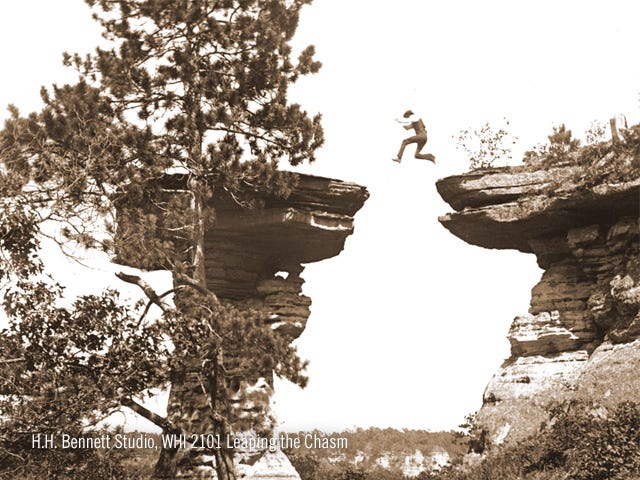Childhood summers meant Cambrian Sandstone.
Unknowingly, I swam in tropical waters—550 million years out-of-sync—among cliffs where the fossilized remains of Ancient jellyfish cohabitate with 5-year-olds scarfing melty fudge in Wisconsin heat. Neon lights and medusa corpses, enormous waterslides and geological time. Beer.
When the Wisconsin Dells Visitor and Convention Bureau describes downtown as “historic,” it refers primarily to mid-20th-century entrepreneurial drive, the construction of a playground of economic growth and entertainment innovations, the Gustave Adolph Heinekes and, later, Tommy Bartletts of it all. Geologist Marcia Bjornerud calls the area “an irresistible vortex into which most Midwestern parents will eventually find themselves drawn some blistering summer weekend.” For my family, it was many—not some—blistering summer weekends.
But what brought the playground to the region where I learned to negotiate a crowd and, more helpfully, to be isolated underwater was the stone, specifically the weirdness of the shapes carved from it by the evacuation of Ancient water. Like Bjornerud, I know the “vortex” is both economic and paleological. It is also imperial, as between the jellyfish and the lake house my Grandpa built lays a vast history of the Ho-Chunk, who lived there for centuries without building burger joints on top of the mineral art of the evacuated equatorial ocean.
We played mini-golf and slid down twisty plastic slides. We sank down among algae and tried to catch the descendants of primordial sea creatures. We purchased hollow wax figurines and ate under-syruped snowcones.
Among the dead. The deeply dead.
The water in which I swam as a child was not technically in the Dells. It was upriver, on the way to the quarry in Mosinee where Bjornerud describes
the unmistakable imprints of hundreds of jellyfish. These jellyfish were apparently doomed—and immortalized, in spite of their soft bodies—by a storm that tossed them onto the beach and then buried them in a layer of sand before they could decay.
The Wisconsin River flows past the Mosinee jellyfish graveyard to be tainted by my DNA en route to the Bartlett playground and an economic oasis in that chronically neglected part of my home state.
Ellen Wayland-Smith, ruminating on “deep time,” notes that
early invertebrates harnessed aragonite and calcite crystals from the ocean, folding these minerals into their own metabolic cycles to build teeth, bone, and shell. No matter how one looks at it, animal and mineral destinies are linked. (p. 129)
The Cambrian dust can be found on Superior Street in Wisconsin Dells. It is mixed with the industrial detritus left by tourists and the attractions they visit, the exhaust remnants from the Ducks, a stray piece of wax paper tumbling along the gutter—grease from the best burger in this reality or the next slowing it down as it is propelled by the wind.
***
My Grandfather sat me at the bar in Monk’s. Just me. He bought me a burger without a plate, just the shiny paper. He had people to talk to, and I was adorable. I got to see adults talk about commerce. He got to show off his cute grandson with the lisp. We got to have fun, just the two of us. I was a special creature with his special elder.
I was too young to know what the sandstone held, the age and the genetic material and the mineral content. The history. The people and protozoa and the deeply dead. All the special creatures and special elders.
While I sat on a bar stool at Monk’s, my feet dangling precariously high above the floor, the water kept moving toward the Mississippi—the other water of my childhood—carrying my cells with the cells of millions and millions of special lives, single cells, conglomerations of cells, through Ancient history, to reunite with the equatorial ocean that left this rocky land before people replaced it.
When my Grandfather died, I remember thinking his face looked like stone. His body wasn’t him. It was a facsimile of him. He looked like a statue. Similar to, but more solid than, the wax figurines I would receive from the Mold-A-Rama machines after I inserted a nickel he had handed to me.
Mineral into the machine. Molded wax out of the machine. Half a billion years of Cambrian Sandstone blowing down Superior Street.
I’ve written about this part of Wisconsin before, both in fiction and in nonfiction:







